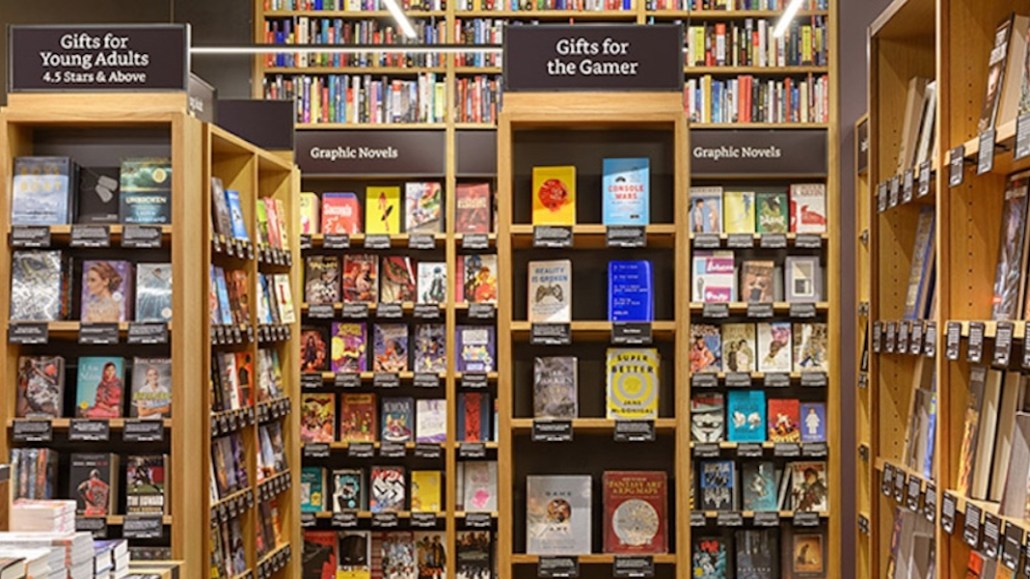Save 50% on a 3-month Digiday+ membership. Ends Dec 12.

It’s often said that Amazon will eventually succeed at anything it puts its time and resources into, and a physical iteration of its selling platform should be no different. In May, the doors to its newest brick-and-mortar bookstore opened in New York City, putting the e-commerce giant’s prowess to a real-life test in America’s shopping capital.
Brands should be paying attention. While traditional retail is suffering through a period of dismantling change, pure-play retailers are realizing there’s still value in a physical store — the trick is getting it right. And who could do it better than Amazon?
Here’s a rundown of what fashion retailers can learn from its foray into physical retail (as well as what Amazon lacks).
Translate online data to a real-life experience
Amazon’s stores are highly curated to display selections that correspond to online customer behavior. Sections dedicated to best-rated books, locally loved books and ones that often appear on wish lists are arranged throughout.
Brands that have similar access to customer data — while perhaps not on the Amazon scale — can follow suit. In some cases, they’re starting to: At Reformation’s newest stores, the sales floor layout is stripped down and streamlined to only display the brand’s top-performing items. The rest of the selection can be browsed via touch screens that show the full online store. (Digital screens as a utility, however, do have their own problems, like a barrier to scale.)
But using the in-store as a space to convey what’s happening online can be effective.
“That’s something that traditional retailers didn’t do very well: Have their assortment based on customer data and behavior,” said Jason Goldberg, svp of content and strategy at SapientRazorfish. “Helping people understand that products aren’t here by accident is a smart strategy.”
While you’re at it, tie in customer reviews
Amazon’s realized that part of the power of its platform is the thousands of reviews that people leave on products. To that end, it’s included ratings and customer reviews alongside products, particularly its own Kindles and Echos.
This is a powerful tool for any retailer, not only those who are sitting on a ton of qualitative data from shoppers, like Glossier, Sephora and Rent the Runway, whose passionate customers are often happy to leave reviews during the purchasing process. Those who don’t already have customer incentives for leaving reviews could jump-start that in store. Who among us hasn’t spent time in an aisle furiously Googling reviews before making a purchase?
“It’s really important to guarantee a great fit,” said Rent the Runway svp of merchandising Sarah Tam, of shopping for apparel. “And what people respond to most are reviews from others with similar body types.”
Prioritize loyalty program perks
In Amazon stores, non-Prime members are treated like second-class citizens, according to Goldberg. They typically pay a different price on products than Prime members, which could drive them to join.
For companies that aren’t Amazon, this could be an extreme move. Not only do Prime members have to have the Amazon app installed on their phones to reap their benefits, but there’s also no clear signage that explains what other benefits are available to members in store.
“If you’re not an advanced Amazon shopper, the experience breaks down pretty quickly,” said Goldberg.
But other brands can follow the mindset that VIP shoppers should be recognized in stores — and before they get to the cash register. Sephora offers in-store events for its top-status Beauty Insiders, while Net-a-Porter is offering offline perks like personal styling services and same-day shipping.
There’s value in a showroom-store hybrid
The showroom model was a way for online retailers, like Bonobos, to offer an in-person experience to customers without the expensive overhead of operating a store’s worth of inventory. The downside: Customers hoping to leave that day with a new purchase in hand are left to order online.
Amazon’s offered a solution to this problem by offering a best-of-both-worlds model: Items displayed are for sale, but it’s not all of Amazon’s inventory — by a long shot — and everything is presented in a way that’s decluttered and easy to interact with. For instance, books are displayed cover-up, ready to be flipped through, and gadgets are unboxed to be played with.
Apparel retailers can use the mannequin-mindset to imitate a clean and easy shopping experience: Keep other sizes and styles tucked away or available for order online, while displaying top selections and making a few prioritized items available for purchase.
“That’s what clears up space for experiences, even for retailers that offer a wide selection of sizes and colors,” said Goldberg.
More in Marketing

In Graphic Detail: Here’s what the creator economy is expected to look like in 2026
Digiday has charted its expected revenue, key platforms for creator content as well as what types of creators brands want to work with.

Ulta, Best Buy and Adidas dominate AI holiday shopping mentions
The brands that are seeing the biggest boost from this shift in consumer behavior are some of the biggest retailers.

Future of Marketing Briefing: AI confuses marketers but their own uncertainty runs deeper
That was the undercurrent at this week’s Digiday Programmatic Marketing Summit in New Orleans.









